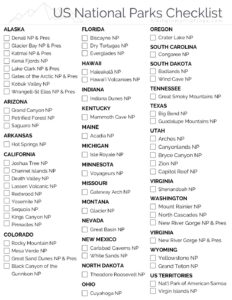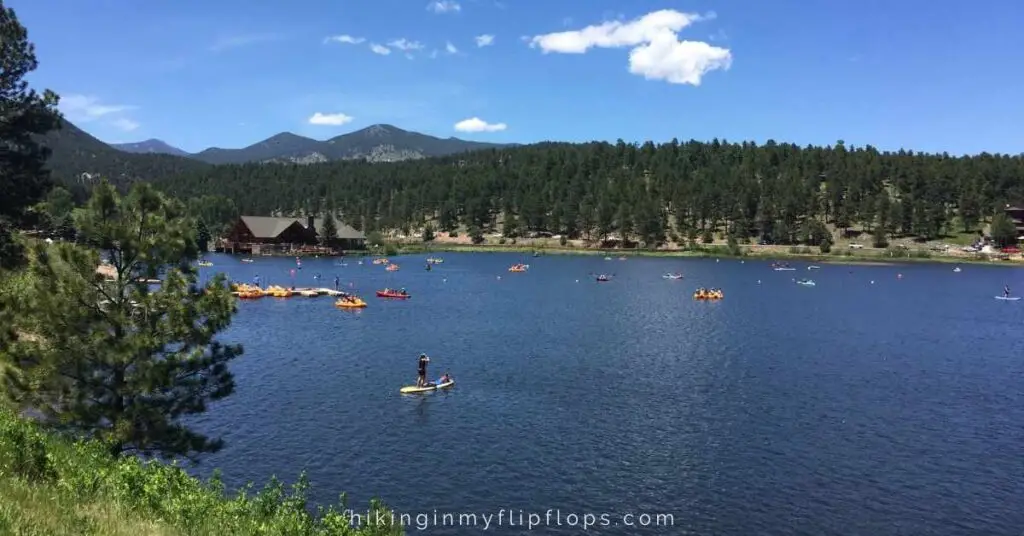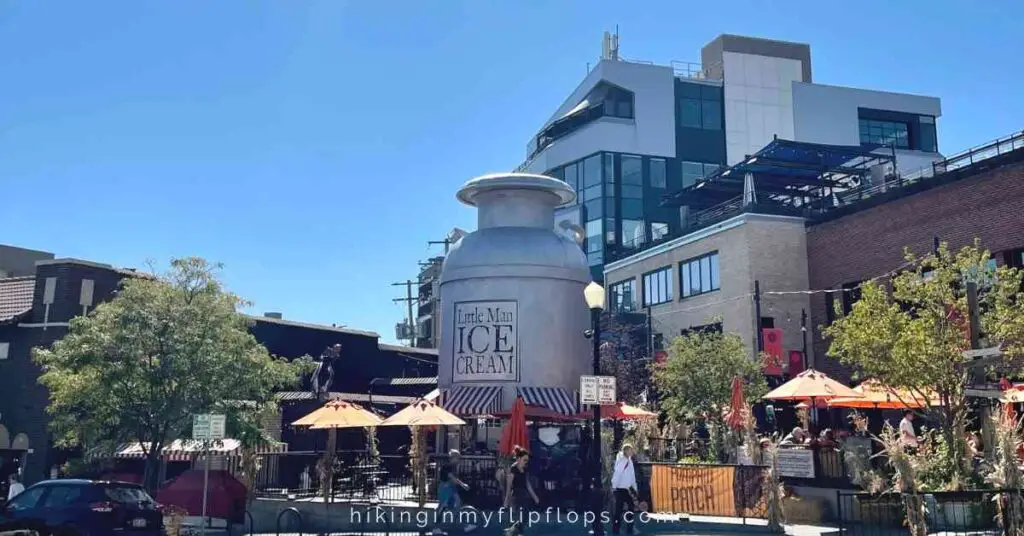The United States has an incredible amount of natural beauty, and there is no better way to experience it than by visiting our national parks. Whether you’re looking for an adventure, want to learn about the variety of gorgeous landscapes across our country, or just want to enjoy nature and wildlife, there is a park for you. This list includes a complete list of US National Parks by state (63 in total, including 2 in US territories) so that you can plan your next adventure!
The US National Park Service (NPS) offers a variety of ways for you to explore the country’s most impressive landscapes, from guided walks and ranger-led programs to scenic drives or hikes. Whether you pack up for an epic family road trip through a few parks or spend a few days exploring every corner of just one, this information will help inspire your next national parks adventure!
(This post may contain affiliate links. Please read our disclosure policy for more information.)

US National Parks Quick Facts
- The US National Park Service’s mission is to “preserve unimpaired the natural and cultural resources and values of the National Park System for the enjoyment, education, and inspiration of this and future generations.”
- The NPS is more than just the national parks: there are more than 400 designated national monuments, preserves, historic sites, seashores, and more.
- There were over 325 million visits to a national park in 2019 (this number includes all of the 423 national park units)
- Yellowstone was the US’s first national park, designated in 1872. The New River Gorge in WV became the 63rd national park in late 2020.
- In Alaska, the 13-million acres of Wrangell-St. Elias National Park and Preserve is the largest national park; Arkansas’ Hot Springs National Park is the smallest at just 5,550 acres.
- Some national parks are also designated national preserves, which allow activities that impact the natural resources (like hunting or mining) in a regulated environment.
- The Great Smoky Mountains National Park frequently ranks as the most visited on the list of US national parks, with over 12 million visits. By contrast, Gates of the Arctic National Park & Preserve has around 10,000 visits annually.
- At many parks, pets are allowed only on paved roads. Before planning a trip with your pet, check the park’s pet policy to ensure they are welcome everywhere you want to explore.
- 15 of the 63 on the list of US national parks are designated International Dark Sky. Plan on some stargazing when visiting any one of these parks. 13 parks are listed on the UNESCO (United Nations Educational, Scientific and Cultural Organization) World Heritage List.
- Despite ample opportunity to capture epic views from above, drones are prohibited in all national park sites.
The List of US National Parks by State
Alaska
Alaska tops the list of US national parks for the most national parks in a state and is also home to the least visited of all national parks due to the difficulty accessing the parks. Many have no roads into them and require travel by plane or boat.
The parks are also among the most diverse. Glaciers, mountains, rainforests, and much more can be experienced in Alaska’s federally protected lands.
Alaska’s parks are also among the largest. Seven of the 8 parks rank in the top 10 largest US national parks.
1. Gates of the Arctic National Park & Preserve
North-central Alaska is home to one of the largest but seldom visited national parks. There are no roads into Gates of the Arctic NP, nor are there any visitor services within the park. The famous Dalton Highway (from History Channel’s Ice Road Truckers) runs along the park’s eastern border, named for the “gate” into the far north Arctic formed by Frigid Crags and Boreal Mountain peaks.
Visitors come to the Gates of the Arctic for birding, climbing, hunting, or fishing on one of the park’s 6 wild and scenic rivers.
2. Kobuk Valley National Park
Kobuk Valley National Park sits near Alaska’s northwest coast (above the Arctic Circle) and is another remote park that can be accessed only by plane. If you never thought anywhere in Alaska could be actually hot, think again. The Great Kobuk Sand Dunes, a popular destination for hiking and camping, can reach 100° F in the summer.
The remote location makes Kobuk Valley NP one of the least-visited national parks.
3. Denali National Park & Preserve
Denali National Park and Preserve is located in the heart of Denali’s mountain range and is one of the largest parks by size. This is where you’ll find the tallest peak in North America, Denali (formerly known as Mount McKinley). Despite the frigid temps, the park is open during the winter months for activities like snowshoeing and viewing the Aurora Borealis.
The park is popular for wildlife viewing, where visitors come to catch a glimpse of grizzly bears, caribou, wolves, Dall sheep, and over 150 species of birds.
Denali National Park & Preserve is about 2 hours from Fairbanks and 4 hours from Anchorage. With its accessibility to Alaska’s larger cities, Denali is the most frequently visited national park in Alaska.
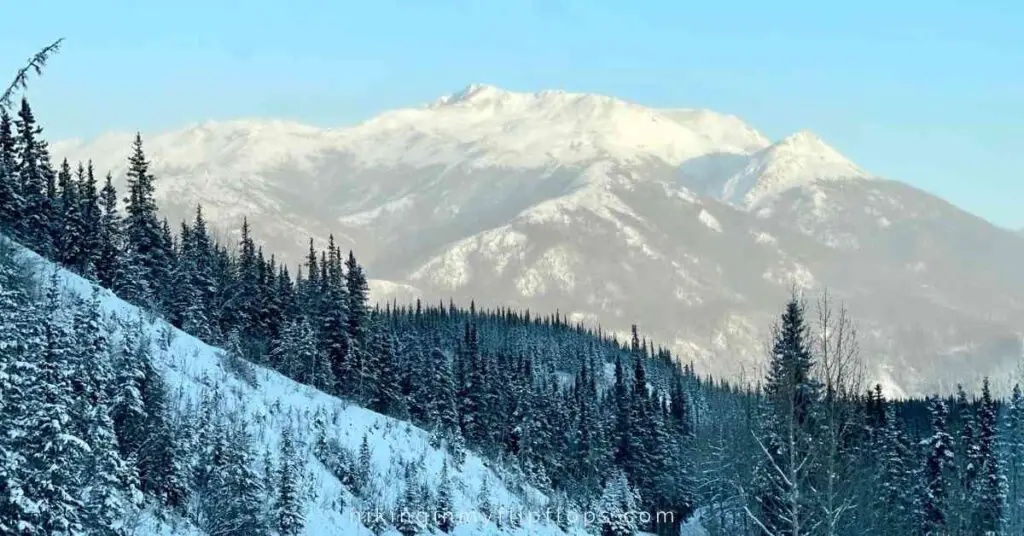
4. Wrangell-St. Elias National Park & Preserve
UNESCO World Heritage Site
The park is located in the southeast corner of the state, about 4 1/2 hours south of Fairbanks and 3 1/2 hours east of Anchorage. It is the largest on the list of US national parks, with landscapes that span from volcanos to glaciers. While visitors can drive into the park, the gravel roads make it difficult. The visitor center in Copper Center, AK, is an excellent stop on a day trip to the park.
5. Lake Clark National Park & Preserve
Just north of Katmai National Park and Preserve is another one of Alaska’s national parks – and another that can only be reached by air or sometimes boat (dependent on the weather conditions). Lake Clark National Park and Preserve is located in the southwest corner of Alaska, near Port Alsworth.
This park is all about the wilderness. The 4 million acres are undeveloped, with few points of interest. Not surprisingly, it is one of the least-visited national parks. Visitors come for the solitude and adventure, but some highlights include the town of Port Alsworth, hiking trails near town, and Kontrashibuna Lake. Proenneke Cabin is also located within the park. (We watched the documentary about Dick Proenneke’s cabin on PBS years ago – the DVD Alone in the Wilderness is sold on Amazon).
5. Kenai Fjords National Park
Kenai Fjords National Park is home to the Harding Icefield and incredible fjord landscapes in Alaska. This land where mountains, ice, and oceans meet is a spectacular place to see sea lions, humpback whales, bears, and marmots. Visitors can get deeper into the park on a boat tour within the park (offered seasonally).
It’s the smallest on the list of national parks in Alaska and, at 600,000 acres, doesn’t even make the top 10 of all national parks. Found 125 miles south of Anchorage, visitors can reach this park by car.
6. Glacier Bay National Park and Preserve
UNESCO World Heritage Site
This Alaskan park is massive. The 3.3 million acres are filled with glaciers, mountains, and fjords. It’s also part of the World Heritage Site, making it one of the largest international protected areas.
Glacier Bay is just west of Juneau but can be reached only by boat or plane, making it one of the least-visited national parks. Peak season is late May through early September, with most people visiting in July. Most of the activity is in Gustavus, where visitors will find everything they need, from lodging and groceries to charter companies and other park services.
7. Katmai National Park & Preserve
Many visit for wildlife viewing, mainly to see the park’s bears. The viewing platforms at Brooks Camp are popular spots to find brown bears fishing for salmon, particularly in July and September. The bears are such a big part of Katmai National Park that they celebrate Fat Bear Week each year when they name the champion for the fattest bear in the park (Otis retook the top spot in 2021, making him a 4-time winner!).
Like Glacier Bay, this national park is accessible only by plane or boat. Katmai National Park & Preserve sits on the northern Alaska Peninsula but is open year-round.
California
California is home to 7 of the 63 national parks. The variety of landscapes makes each park incredibly different and unique.
9. Redwood National and State Parks
UNESCO World Heritage Site
Redwood National Park sits at the southern end of a series of state parks in the northern part of the state – about a 6-hour drive north of San Francisco. The giant Redwoods are the tallest trees in the world and are the primary draw to this park. The trees that start from a seed the size of a tomato seed can grow well over 300 feet tall.
But there is much more to the park than the Redwoods. Beyond the towering trees, explore prairies, rivers, and the rugged California coastline.
10. Lassen Volcanic National Park
In the northern part of the state is a park filled with rocks originating from volcanoes. There hasn’t been an eruption for about 100 years, but many signals from the ecosystem indicate there will be another eruption at some point.
Explore the park by driving the Lassen Volcanic Park highway and, if you have the proper vehicles for the dirt roads, visit more remote areas of the park. Keep an eye out for bears, foxes, mountain lions, hares, and pikas along the route.
11. Yosemite National Park
UNESCO World Heritage Site
The home of El Cap and the Half Dome was the 2nd on the list of US national parks, designated in 1864 (18 years after Yellowstone became a national park). Yosemite National Park ranks in the top 10 most visited and is particularly loved by climbers. To learn more about the climbing culture at Yosemite, watch the documentaries Valley Uprising and Free Solo.
Yosemite is an easy 4-hour drive from San Francisco, making it a great weekend getaway. This park gets VERY crowded, so we recommend taking that weekend getaway during the week if you can!
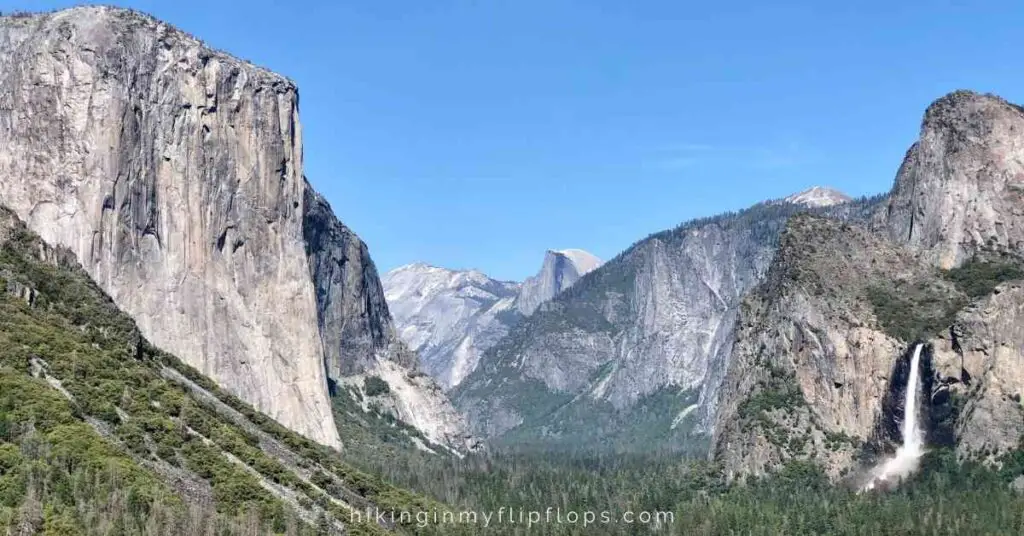
12. Kings Canyon National Park
Known for the giant Sequoia trees, Kings Canyon NP is home to the world’s largest grove of sequoia trees and the second-largest tree: the General Grant Tree. It’s said that John Muir called Kings Canyon a “rival to Yosemite” because of the impressive valleys and towering trees.
13. Sequoia National Park
Kings Canyon NP’s neighbor to the south is also known for its massive sequoias. The park is home to the largest tree in the world, the General Sherman Tree. Visitors also make a point to drive through a tunnel carved from one of the fallen sequoias. Various landscapes, from mountains and foothills to canyons and caverns, are also found within these parks.
Sequoia and Kings Canyon National Parks are equidistant from San Francisco and Los Angeles, making them a great addition to a northern or southern California road trip. The close proximity of the two parks, which are usually referenced together, makes it easy to explore both during your visit.
14. Pinnacles National Park
To the west of Sequoia NP is Pinnacles National Park. It is known for the unusual and sometimes spectacular rock formations created by volcanic eruptions 23 million years ago. The result was a beautiful and unique landscape.
Consider visiting at least one of two caves within the park, Bear Gulch or Balconies, while you’re there. Just check the status in advance – they close periodically for various reasons, from rockfalls to bat populations.
Pinnacles National Park is located in central California, about 1 1/2 hours from San Jose.
15. Death Valley National Park
International Dark Sky
Death Valley NP is directly east of Sequoia National Park. This park ranks as the lowest point in North America (at 282 feet below sea level) and is the hottest spot in the world (with a record high of 134° F/57° c). It’s easily the hottest, driest, and lowest on the list of US national parks.
Just 2 hours from Las Vegas, visitors can stay at one of the 3 hotels or 9 campgrounds within the park. However, rangers suggest planning your itinerary carefully as these accommodations are spread over 3.4 million acres.
16. Channel Islands National Park
Visiting this park requires planning since it is located off the coast of California, almost directly west of Los Angeles. There are actually 5 islands in the park, and all are accessible only by boat. Once on the island, visitors can explore only by foot or kayak. Travel times to the islands range from one to four hours.
The visitor center is on the mainland, so if you can’t make it to the islands, you can still experience Channel Islands NP.
17. Joshua Tree National Park
International Dark Sky
The southernmost on the list of national parks in California is an 800,000-acre park comprised of two separate desert ecosystems: the Mojave and the Colorado. The park is accessible from Los Angeles, San Diego, Las Vegas, and Phoenix, making it a perfect stop on a southwestern road trip itinerary. Visitors can experience hiking, stargazing, and horseback riding in a desert landscape. Stay the night at one of the 9 campgrounds. A particular favorite is Jumbo Rocks, where campsites are nestled within big rock formations.
Utah
No visit to Utah is complete without a stop at at least one of the national parks, known as “the mighty 5“. Or make it an epic road trip to visit them all: it’s about 12 hours of driving in well under 1,000 miles.
All 5 national parks in Utah are designated International Dark Sky Park, making them impressive spots for stargazing.
18. Arches National Park
International Dark Sky
Towering red rocks form beautiful arches throughout the park. In fact, there are over 2,000 of them, making it the densest collection of arches in the world. Hiking trails wind through and around the arches, where you can explore them up close. The crowning feature is the Delicate Arch. The difficult-rated hike to this arch takes about 2.5 hours to cover the 3-mile (round trip) distance. The brilliant sunshine, especially in the summer months, requires extra caution, so plan carefully.
Arches National Park is one of two on the list of national parks in Utah near the eastern border in Moab.

19. Canyonlands National Park
International Dark Sky
The second national park in Utah, just 30 minutes from Arches, contains over three million acres of land divided into 4 districts. The Canyonlands National Park districts are not connected by road, so plan for multiple days if you want to explore them all. If you have just a day here, Island in the Sky is the one to do. You’ll take in the most impressive views of canyons, mesas, and rivers.
Traveling in a high-clearance 4-wheel drive? Don’t miss Shafer Trail Road, the nail-biting dirt road into the canyon. It’s not for the faint of heart, but the moderate off-road trail is accessible to many vehicles. Once you go in, however, there’s no turning back!
20. Capitol Reef National Park
International Dark Sky
Two and a half hours southwest of Canyonlands is Capitol Reef NP, named for the dome rock’s resemblance to the shape of capitol buildings. Within the park is the 100-mile-long Waterpocket Fold in the Sout District. The fold is a warp in the earth’s crust, where the rocks on the west side shifted 7.000 ft higher than those on the east. In the North District is Catherdral Valley, where high-clearance vehicles are required to drive the 60-mile loop tour through the monoliths (plan on 6-8 hours of driving).
When visiting this fossil-filled park, plan a stay in a TeePee or Conestoga Wagon at Capitol Reef Resort, just minutes from the park.
21. Bryce Canyon National Park
International Dark Sky
Continuing towards the southwestern corner of Utah from Capitol Reef NP is Bryce Canyon National Park, a park filled with columns of red rocks called hoodoos. In fact, Bryce Canyon has the highest concentration of hoodoos in the world. It’s part of the Grand Staircase that stretches 100 miles through Zion National Park and into the Grand Canyon.
Stargazers not only love the incredible night skies here but also flock to the park every June for the annual Astronomy Festival.
22. Zion National Park
International Dark Sky
Zion NP stakes the claim for the first designated national park in Utah. This busy park is among the top 10 most visited national parks. This is likely partly due to two hiking trails on many bucket lists: Angels Landing and The Narrows. Angels Landing doesn’t require a permit, but the trail features a steep, narrow ridge that is not recommended for children or those who fear heights. Advanced planning is necessary for The Narrows to secure a permit for the trail.
Colorado
Like California, each park on the list of US national parks in Colorado is a vastly different experience. Find massive sand dunes, snow-capped mountains, ancient cliff dwellings, and impressive canyons across the state.
Three of the 4 parks are designated dark sky, making Colorado parks excellent for stargazing.
23. Rocky Mountain National Park
The northernmost and most popular park in Colorado is Rocky Mountain National Park. Many visit to see wildlife, including elk, bighorn sheep, and bears, and drive Trail Ridge Road, the highest continuous paved road in the US at just over 12,000 feet above sea level.
Drive Trail Ridge Road between the east entrance in Estes Park to the west entrance in Grand Lake, stopping at overlooks and points of interest like the Holzwarth Historic Site. In the summer months, visitors have the opportunity to make the westbound drive on the one-way Old Falls River Road that ends at the Alpine Vistors Center. At 11,796 feet, it is the highest elevation visitor center in the national park system.
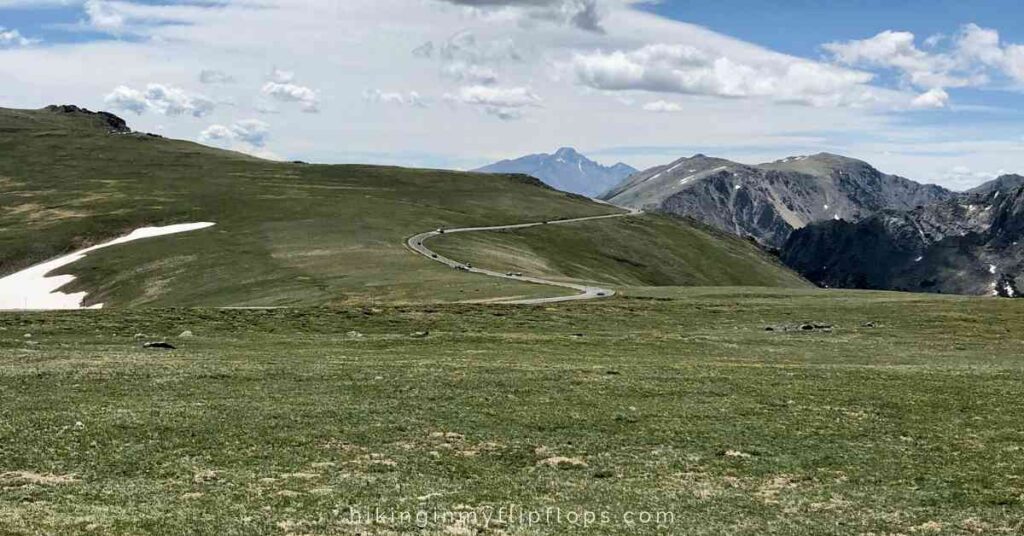
24. Black Canyon Of The Gunnison National Park
International Dark Sky
Some of the steepest cliffs are right here in the Black Canyon of the Gunnison NP. It’s also home to the Peregine, the fastest bird in the world. Visitors can hike along the rim or, with a free permit, make their way into the inner canyon for kayaking, rock climbing, fishing, or just exploring. The dark sky designation means it’s an excellent stargazing spot too.
Many who have visited the park believe it’s one of the most underappreciated on the list of US national parks.
25. Great Sand Dunes National Park & Preserve
International Dark Sky
Southeast of the Black Canyon of the Gunnison is a Colorado gem: The Great Sand Dunes National Park and Preserve. The dunes are one of the most unique Colorado experiences. From late spring to early summer, snowmelt fills Medano Creek, which sits mostly dry the rest of the year in front of the dunes. All year long, visitors to the park come for hiking and sandboarding on the dunes.
When the sun goes down, the stars come out in this designated dark sky park, and people flock back onto the dunes in the pitch dark for some of the most incredible night skies.
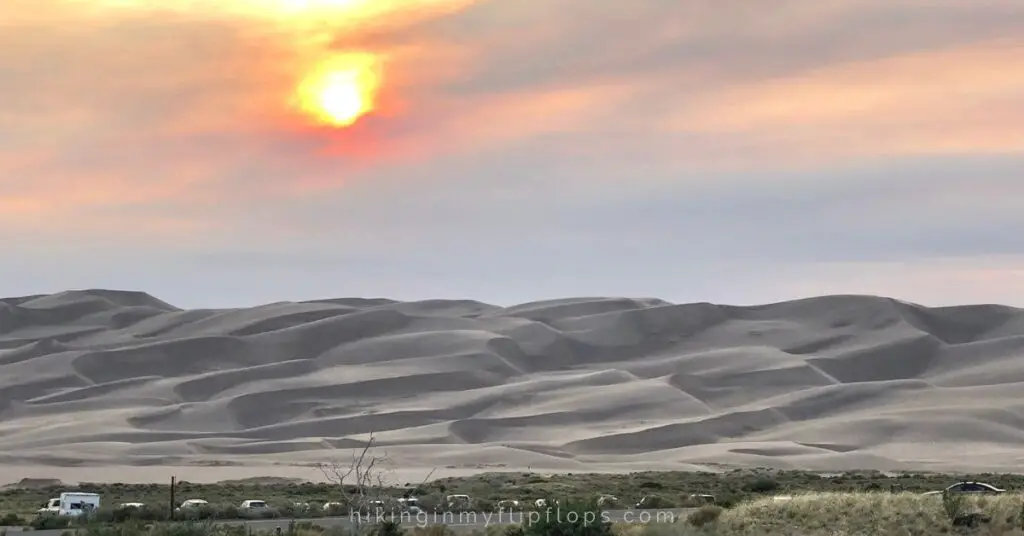
26. Mesa Verde National Park
UNESCO World Heritage Site; International Dark Sky
Mesa Verde NP is home to a collection of well-preserved ancient cliff dwellings built nearly 1,000 years ago by Ancestral Pueblo people. Visitors to the park can join ranger-led tours to experience the dwellings up close. Tickets can be purchased here. Those who aren’t up for the hikes to the ancient dwellings or can’t get tickets can drive the 6-mile Mesa Top Loop Road while listening to a downloadable audio tour of the dwellings.
Lodging and camping within the park are available seasonally, giving the perfect opportunity to catch the brilliant stars in Colorado’s 3rd designated dark sky national park.
Arizona
Arizona is home to 3 national parks that nearly span the state, from north to south. The Grand Canyon is the most famous, but there are two other unique national park experiences you won’t want to miss in Arizona.
27. Grand Canyon National Park
UNESCO World Heritage Site; International Dark Sky
It’s the second most frequently visited national park but arguably the most well-known. It is famous for its massive canyon, which is surprisingly only the eighth largest in the world. Many come to the park for the impressive views, but there is much more to do. Hiking, sunrise and sunset viewing, river rafting, and biking are just a few things to do at Grand Canyon NP. Those who stay within the park can also do some stargazing.

28. Petrified Forest National Park
International Dark Sky
Petrified Forest NP sits on the southern end of the Colorado Plateau, about an hour and a half east of Flagstaff and 3.5 hours northeast of Phoenix. It’s the most pet-friendly of the 63 US national parks with its BARK Ranger program. Plan for some hiking, horseback riding, and geocaching in the Painted Desert and throughout the mesas and buttes when visiting Petrified Forest, Arizona’s second dark sky national park.
29. Saguaro National Park
Arizona’s southernmost park is home to the largest cacti in the US, named for the majestic saguaro (pronounced suh·waa·row). There are a variety of hiking trails throughout the two districts in the park. Catch epic sunsets at Tanque Verde Ridge Trail or the Javelina Rocks pullout on the park’s east side in the evenings.
Saguaro NP’s proximity to Tuscon makes it a perfect addition to your southwest road trip itinerary.
Washington
Washington state is also home to 3 national parks, each located on the western half of the state and within 2 1/2 hours from Seattle.
30. North Cascades National Park
North Cascades National Park covers more than 300 glaciers near the US-Canada border. Jagged, snow-capped mountains surround blue lakes where many visitors go boating and fishing. Hiking and camping are popular here too, of course.
Despite its proximity to Seattle, this is one of the least visited parks, making it an excellent alternative to parks like the busy Rocky Mountain NP or the remote national parks of Alaska.
31. Olympic National Park
UNESCO World Heritage Site
It is known for its incredibly diverse landscape, including glaciers, coastlines, and one of the few remaining temperate rainforests in the world. The one million-acre park is popular with mushroom foragers. It is home to 1,400 species (both edible and poisonous) that visitors can collect up to one quart per day.
The park is active year-round with hiking, fishing, and climbing in the summer and tubing, skiing, and snowshoeing in the winter.
32. Mount Rainier National Park
This park is defined by fire & ice. The crowning feature of Mount Rainier is the most glaciated in the (contiguous) US but is also an active volcano. The mountain reaches over 14,000 feet above sea level and is a prominent feature of the Washington landscape. Like Olympic NP, Mount Rainier is another popular destination for those foraging for mushrooms.
Mount Rainier NP is just as impressive in the winter as in the summer but requires extra precautions such as tire chains to travel safely in the winter conditions.
Florida
All three of Florida’s national parks sit deep in the southern part of the state
33. Biscayne National Park
Biscayne NP is one of two on Florida’s list of US national parks that is 95% water. While the visitor center is located on the mainland, most of the park’s 173,000 acres require a boat to access the three islands. Boca Chita Key, Elliott Key, and Adams Key offer camping, hiking, swimming, and more on the islands surrounding the park’s coral reefs.
Visitors come for kayaking, canoeing, snorkeling, and fishing. Less than 1 hr from Miami, visiting Biscayne NP makes a perfect day trip when visiting southern Florida.
34. Everglades National Park
UNESCO World Heritage Site
Travel another 30 minutes southeast of Biscayne to reach Everglades NP, the largest subtropical wilderness in the US. The park is filled with wildlife, including manatees, crocodiles, panthers, and invasive species like the Burmese python. It is an excellent spot for birdwatching with more than 360 species. The park is also home to a continuous cluster of mangroves (groups of several trees) larger than anywhere else in the western hemisphere.
When visiting the Everglades, don’t miss the opportunity to take an airboat tour. Kayaking and canoeing opportunities are abundant in the Everglades. Hundreds of miles of water trails range from short day trips to longer multi-day trips (there are multiple camping areas throughout the park). Those who prefer to explore the Everglades a little further from the water can bike along the five biking trails throughout the park.
35. Dry Tortugas National Park
About 70 miles west of Key West sits the 7 small islands that make up Dry Tortugas NP. The seldom-visited park is accessible only by seaplane or boat – whether it’s your vessel or a chartered trip. Those who visit the park come for historic Fort Jefferson, snorkeling in the pristine coral reefs, or taking in views of the perfectly blue waters. Birds, sea turtles, and other marine life are abundant in the park, making Dry Tortugas a spectacular spot for wildlife viewing.
Can’t make it to the park? The next best thing is to visit the Dry Tortugas National Park Museum, more conveniently located on the island of Key West.
Hawaii
36. Haleakalā National Park
This Hawaiian park is as much about the people as the land. At Haleakalā National Park, visitors can learn about the island’s earliest inhabitants, hike the Keonehe‘ehe‘e Trail into the crater, and even come face-to-face with a Hawaiian Wolf Spider, which only is found on these islands. The crowning feature of the park is the dormant volcano, which offers incredible sunrise views.
Haleakalā NP is located on the southwest side of Maui.
37. Hawai’i Volcanoes National Park
UNESCO World Heritage Site
Cross the Maui Channel to the Island of Hawai’i to visit the state’s other national park. The highest summit of the two of the most active volcanos in the world reaches over 13,000 feet. Volcanic eruptions are as recent as September of this year!
Tour the park along Crater Rim Drive to see Halemaʻumaʻu crater, water vapor from a volcano, and a 500-year-old cave formed from a lava river.
The Dakotas
There are just 2 on the list of national parks in South Dakota and one in North Dakota.
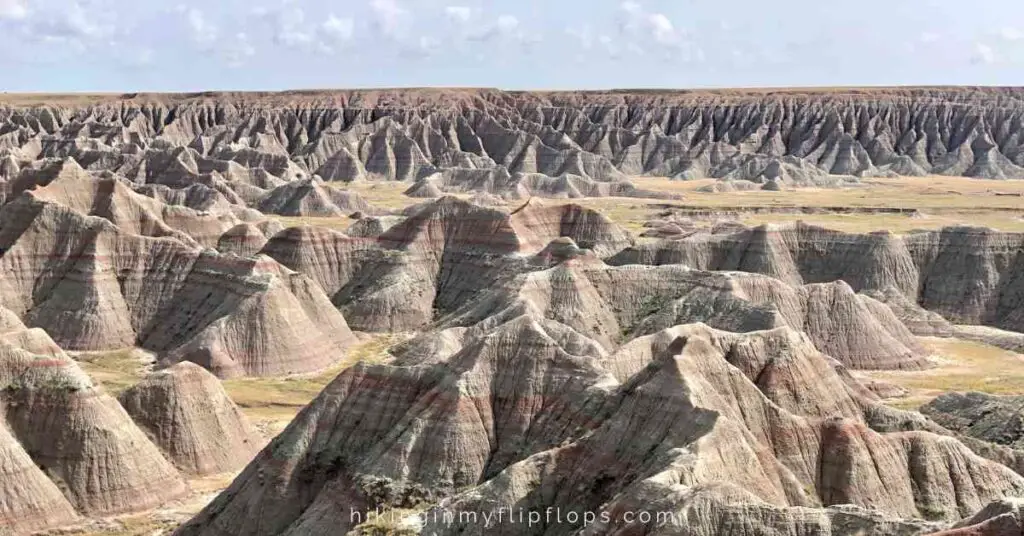
38. Theodore Roosevelt National Park in North Dakota
Near the western border of North Dakota, Theodore Roosevelt NP is the inspiration behind the conversation efforts of the would-be president while hunting bison in the area. Today, it’s a popular place for hiking, biking, camping, and canoeing.
But this park really comes alive after dark. It’s a spectacular place for stargazing, and the wildlife fills the park with activity once the sun goes down. If you time your fall visit just right, you can experience one of the many activities during the annual Dakota Nights Astronomy Festival.
39. Badlands National Park in South Dakota
Whether you visit for the fascinating geology or the variety of wildlife, there is much to see at Badlands NP. The massive rock formations erode by one inch per year but leave impressive views in every direction. The land of sandstone, claystone, and volcanic ash is home to bison, bighorn sheep, ferrets, prairie dogs, and pronghorns.
It’s an easy trip to Badlands when taking a road trip through South Dakota. The park is just 1 1/2 hours from Mount Rushmore and 4 hours from Sioux Falls.
40. Wind Cave National Park
About 2 hours west of Badlands NP is one of the world’s longest and most complex caves. At Wind Cave National Park, visitors can join a ranger-led tour through one of 3 areas of the caves (check here for schedules, difficulty, and pricing).
There is one campground within the park. There are over 100 sites that accommodate tents or RVs but no hookups. All sites are first-come, first-served, so plan your stay accordingly.
Wyoming
Wyoming is home to 2 popular national parks, including one that sprawls into Idaho and Montana.
41. Yellowstone National Park
UNESCO World Heritage Site
Designated in 1872, Yellowstone was the first entry on the list of US national parks. The park is open year-round but is most active in the summer months. Millions visit the park each year to see the hot springs, geysers, and other hydrothermal features. It’s also a popular spot to see wildlife like bears, wolves, bison, and mountain goats. Visitors also won’t want to miss a stop at Old Faithful and Mammoth Hot Springs.
Like Grand Canyon NP and Yosemite NP, Yellowstone has nearly every amenity within the park – from lodging and restaurants to RV repair services and general stores.
42. Grand Teton National Park
Just south of Yellowstone, Grand Teton NP is another one of the most visited on the list of US national parks. The crown jewel of this park is the mountain range for which the park is named. These mountains started forming billions of years ago, resulting from two continents colliding and pushing the earth into the magnificent mountain range we see today.
New Mexico
The southwestern state is home to 2 national parks, one named only recently. Even though the two parks aren’t very far apart, the roads to travel between them make the drive more than 3 hours.
43. White Sands National Park
Gypsum sand fills 275 square miles of White Sands NP, one of the more recent additions to the list of US national parks. It’s home to the world’s largest gypsum dunefield. Visitors to the park can sled down, bike around, or drive into the heart of the dunes. The 8-mile road is a one-of-a-kind driving experience. Dunes Drive is periodically closed for missile testing in the area, so check the status ahead of your visit.
There are also hiking and camping opportunities throughout the park. There are limited amenities available, so plan your visit accordingly.
44. Carlsbad Caverns National Park
UNESCO World Heritage Site
Southeast of White Sands NP is another New Mexico national park known for caves and desert landscapes. Explore the caves (either ranger-led or on your own, but both require reservations), drive the scenic Walnut Canyon Desert Drive, and plan a picnic at Rattlesnake Springs. In the summer months, visitors have the chance to see Brazillian free-tail bats come out from the caves around sunset.
Unless you’re planning for backcountry camping, a visit to Carlsbad Caverns NP will be a day trip, as there are no accommodations within the park.
Texas
The great state of Texas has just 2 national parks.
45. Guadalupe Mountains National Park
Just a half-hour south of Carlsbad Caverns NP is a west-Texas park where visitors come to experience mountains, canyons, and desert landscapes. Guadalupe Mountains NP was once home to Mescalero Apaches and where the 4 tallest peaks in Texas are located, including Guadalupe Peak at nearly 9.000 feet above sea level.
The park is also home to more dunes. Put Salt Basin Dunes on your itinerary to see the bright white gypsum dunes.
46. Big Bend National Park
International Dark Sky
The southwest corner of Texas is home to Big Bend NP. This massive park takes more than a day to really see it all. If that’s all the time you have, you can still get a great experience. Drive along Ross Maxwell Scenic Drive, take a few short hikes, and spend time at the visitor center. If you have more time, plan to discover fossils, explore the back roads, or take a river trip along the Rio Grande.
For more extended visits, choose from lodging at Chisos Mountain Lodge or camping at one of the 3 campgrounds within the park.
States with One National Park
47. Montana’s Glacier National Park
The far north of Big Sky Country is home to Glacier NP, Montana’s only national park. home to roughly two dozen active glaciers. Many are difficult to see up close since they are accessible by some of the more challenging hiking trails. The easiest to see is Jackson Glacier, viewable from an overlook on the famous Going-to-the-Sun Road.
Despite the more remote location (the park is 2+ hours from Montana’s larger cities), it is one of the more popular national parks, ranking in the top 10 most visited.
48. Crater Lake National Park in Oregon
Most people visit Oregon’s national park to see the lake, but a lucky few get to see it. Crater Lake is the deepest lake in the US, nearly 2,000 feet deep, and is often hidden within the clouds. A volcanic eruption almost 8,000 years ago led to a collapsed mountain peak and the awe-inspiring lake.
The year-round park located about 4 hours south of Portland is an outdoor lover’s dream. There is an activity for everyone, from camping, biking, and fishing in the summer months to skiing, sledding, and snowmobiling in the winter months.
49. Voyageurs National Park in Minnesota
International Dark Sky
Fish for walleye, get a chance to experience the Northern Lights, or sleep in a houseboat at Voyagers NP. And those are just a few things Minnesota’s national park has to offer. Year-round activities abound with so many ways to play in the park.
Foragers can hunt for mushrooms, animal lovers can try to get a glimpse of a Gray Wolf, and stargazers can experience some of the most incredible night skies.
50. Missouri’s Gateway Arch National Park
A second park in the list of US national parks sits in an urban setting. St. Louis’ Gateway Arch NP is surrounded by highways in the city’s center. The arch was completed in 1965 as a symbol of the Westward Expansion. Visitors can take the tram to the top of the 630-foot arch.
Also within the park is the Old Courthouse whose historical significance includes the trial in the Dred Scott Case.
51. Indiana Dunes National Park in Indiana
On the southern tip of Lake Michigan, Indiana Dunes NP is one of the newer national parks. The 15 miles of sandy shoreline is a perfect spot for flying kites, bird watching, and swimming. There are plenty of more traditional national park experiences too. Camping, hiking, horseback riding, and fishing are plentiful within Indiana Dunes. Visiting in winter? Try snowshoeing or cross country skiing in the park!
Visitors to the park in early September have an opportunity to participate in the Outdoor Adventure Festival. This annual (and free!) celebration has countless activities planned over the weekend-long event.
52. Mammoth Cave National Park in Kentucky
UNESCO World Heritage Site
The highlight of a trip to Mammoth Cave NP is the world’s most extensive cave system, located between Louisville, KY, and Nashville, TN. Choose from a variety of tour options and reserve your spot in advance. History buffs will also enjoy visiting one of the historic churches and cemeteries that were once part of the active communities within what is now designated a national park.
Take advantage of camping and lodging inside the park and stay long enough to add kayaking or hiking to your itinerary.
53. Maine’s Acadia National Park
Maine’s national park covers 47,000 acres on the southern border of the state. Despite being within the easternmost border of the US, it is still in the top 10 most visited on the list of US national parks. Peak season (May through October) requires reservations to drive the 3-mile route along Cadillac Summit Road to Cadillac Mountain.
Acadia is filled with various landscapes including mountains, shorelines, forests, and marshes, and is an excellent place for stargazing.
54. Isle Royale National Park in Michigan
Isle Royale NP sits in Lake Superior right near the Canadian border but is technically in Michigan. The far north location is difficult to access in the winter months, so it is closed to visitors from November 1 through April 15. The isolated island makes it one of the least-visited national parks.
The 200 square miles that make up the island are filled with hiking trails, and campgrounds, and the surrounding waters are a perfect place for scuba diving, swimming, kayaking, and boating.
55. Hot Springs National Park
Arkansas’ only national park is the smallest on the list of US national parks, located about an hour east of Little Rock. This unique park isn’t just the natural landscape. Bathhouse Row is lined with historic buildings that were once a place for guests to soak in water from the nearby hot springs. Take a self-guided tour through the historic buildings to get a glimpse of life when visitors would flock to the springs for a therapeutic soak.
After a day of exploring the 20th-century bathhouses, stop into the Superior Bathhouse Brewery to taste beers and root beer brewed with local hot springs water. The pet-friendly brewery has delicious food too!

56. Great Basin National Park in Nevada
International Dark Sky
Located near the eastern border of Nevada, Great Basin NP makes a great side trip from Las Vegas or addition to a tour of Utah’s “mighty 5” national parks. There is a little bit of everything at Great Basin: mountains, desert, lakes & rivers, and caves.
Visitors also get the opportunity to see species of wildlife that are found nowhere else in the world. Species of animals (including shrimp, spiders, and rabbits) and plants native to the mountain area have not been able to migrate across the desert that surrounds the mountain and are now endemic.
57. Ohio’s Cuyahoga Valley National Park
Just a half-hour south of the bustling city of Cleveland is a quick escape into nature at Cuyahoga Valley NP. Visitors make their way to Ohio’s only national park for hiking, biking, and paddling. Or explore the park from the Cuyahoga Valley Scenic Railroad that runs through the valley and along the Cuyahoga River.
Visitors should not miss Beaver Marsh, Brandywine and Blue Hen Falls, and The Ledges. Another popular spot is the Towpath Trail which runs along the Ohio & Erie Canal. A 20-mile section of the path within the park is filled with hikers, bikers, and skiers.
58. South Carolina’s Congaree National Park
The large hardwood forest that makes up Congaree NP is less than 30 minutes southeast of Columbia, SC, and less than 2 hours from Charlotte, NC. The biodiverse park is filled with forested wetlands, lakes, and creeks. The towering trees create a canopy over the park, and the massive hardwoods and the tallest pines make a relaxing sanctuary in the forest. Visitors come to the South Carolina park to camp, hike, fish, kayak, etc.
59. Great Smoky Mountains National Park
UNESCO World Heritage Site
Great Smoky Mountains NP is by far the most frequently visited on the list of us national parks. It spans the borders of eastern Tennessee and western North Carolina, making it easily accessible whether you’re visiting Knoxville, TN, or Asheville, NC.
There is no shortage of things to do or see in the Great Smoky Mountains. Hike to one of many waterfalls throughout the park, visit one of the burial landscapes, view wildlife like bears, elk, and turkeys, take a bike ride along the 11-mile Cades Cove Loop Road (when closed to vehicle traffic). Or spend time at the Mountain Farm Museum and Mingus Mill to learn about the area’s history.
60. Shenandoah National Park
Skyline Drive was created to be the highlight, or “greatest single feature”, of Shenandoah NP. The 105-mile route of exhilarating views of the valley, Piedmont Plain, and even the Washington Monument. The drive through Mary Rock Tunnel and add a stop at the high-elevation meadow called Big Meadows located in the center of the park near mile mark 51.
The park is located about 1 1/2 hours northwest of Richmond, VA, and east of Washington DC. The NPS recommends planning your route to one of the 4 entrances to avoid any GPS taking you on roads that are not accessible to the public.
61. New River Gorge National Park and Preserve
The newest national park in West Virginia has only recently been designated a national park in 2020. The New River Gorge is a wildly popular spot for whitewater rafting (we loved the guides and accommodations with ACE Adventure Resort). Another park highlight is the New River Gorge Bridge which transformed transportation in the area when it was completed in 1977. Time your visit for late October to catch “Bridge Day” when the bridge is opened to pedestrian traffic, including BASE jumping and rappelling during the Saturday festival.
New River Gorge NP & Preserve is just 3 1/2 hours from either Charlotte, NC, or Richmond, VA.
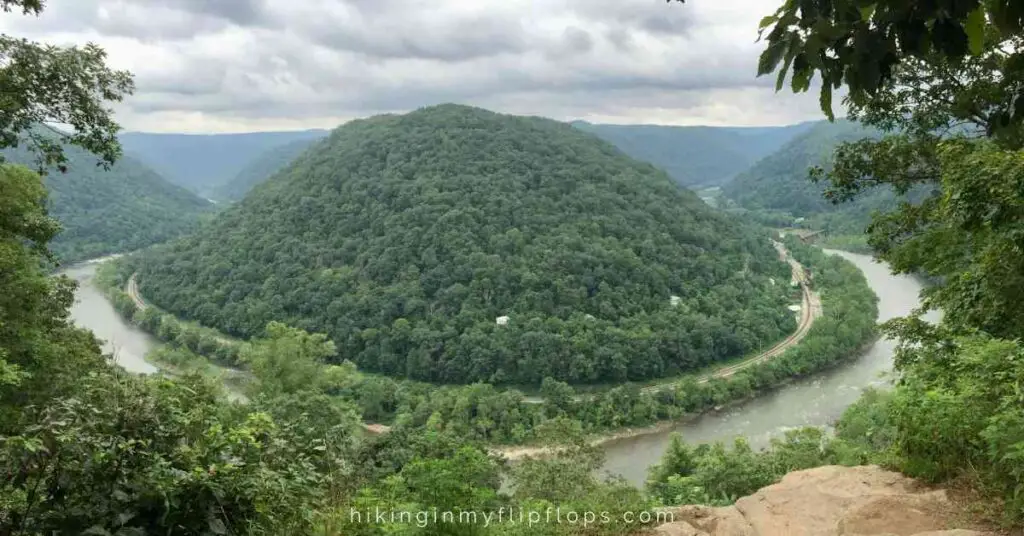
National Parks in the US Territories
The list of 63 US national parks extends beyond the 50 states, with two national parks in US territories.
62. National Park of American Samoa
From snorkeling and diving to hiking and beachcombing, a visit to the National Park of American Samoa is a seldom-visited park due to its distance from any mainland. It can take over 24 hours to reach the island from the US. Still, the beauty of the island and national park, which includes 4 volcanic islands, is worth visiting for the lucky few to come to American Samoa.
From fruit bats to whales, plenty of wildlife inhabit the area. The park is mostly rainforest but includes nearly 3,000 acres of coral reef.
63. Virgin Islands National Park
Add a little adventure to your island getaway. The white sand beaches of the Virgin Islands NP are located on the island of St. John. The park is more than just the beaches, however. Historic plantations, petroglyphs, coral reefs, and plenty of wildlife are also featured on the Caribbean island. Plan for hiking, fishing, snorkeling, or learning more about the park at the visitor center while you’re there.
Visits to this park are day trips only as there are no overnight accommodations within the park.
Track Your Visits: A Printable List of National Parks
